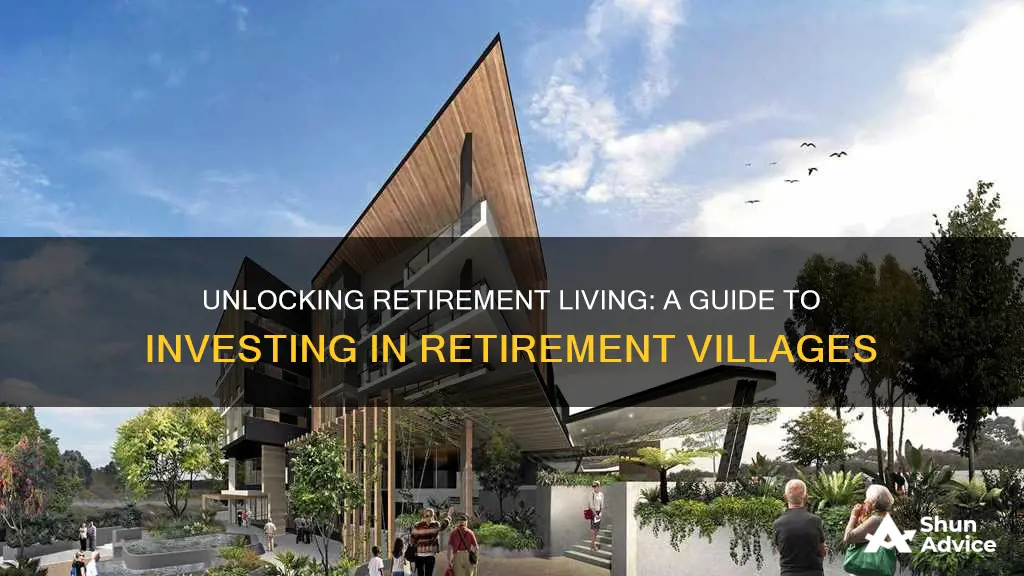
With the world's population ageing rapidly, the retirement living sector is booming. Retirement villages are purpose-built communities that cater exclusively to retired people over a certain age, usually over 50 or 65. They are designed for retirees who are still independent, but the houses often have wider hallways and no stairs to accommodate mobility devices. Retirement villages can be a good investment opportunity, but it is important to be aware of the potential hidden costs and fees associated with them. For example, there may be monthly maintenance fees, exit fees, and recurrent charges for repairs and maintenance of the village. It is also important to understand the different types of contracts and finance models used in retirement villages, such as outright ownership, the loan licence model, and the leasehold or sublease model.
What You'll Learn

The pros and cons of investing in retirement villages
Retirement villages are a growing sector, driven by the world's ageing population. They can be a good investment, but there are also challenges and risks. Here is a detailed look at the pros and cons of investing in retirement villages.
Pros
- Strong demand and growing market: With the global population ageing, the retirement living sector is booming. This means there is strong demand for retirement villages, and this demand is only expected to grow.
- Accommodation options: Retirement villages typically offer a range of accommodation options, from independent living units (ILUs) to serviced apartments, catering to retirees with different needs and preferences.
- Rental retirement villages: These are the most common form of investment in the retirement sector. They allow investors to buy units specifically for renting to elderly tenants. While this model is still evolving in some countries, it offers a direct way for investors to enter the retirement sector.
- Low acquisition cost: Retirement village units are typically much cheaper than standard residential properties, with some available for under $100,000.
- Potential for capital gains: While capital gains may be constrained by limited rent increases, there is still potential for investors to benefit from capital gains when selling their units.
- Management companies: Retirement villages are often managed by specialist companies, which can handle the day-to-day operations, leasing, and maintenance. This can reduce the workload for investors.
Cons
- Limited financing options: Banks and other financial institutions may be hesitant to lend against retirement village assets, making it challenging for investors to secure financing for their purchases.
- Lower rental yields: In some countries, such as Australia, rental yields in retirement villages may be lower than market rates due to the need to consider aged pension and rental assistance allowances. This can impact the overall investment returns.
- Management risk: The performance of a rental unit in a retirement village is heavily dependent on the effectiveness of the village manager in driving occupancy and rental growth. Poor management can negatively impact investment returns.
- Limited resale market: There may not be an efficient secondary resale market for retirement village units. Real estate agents may be reluctant to list these properties due to the low selling prices and commissions.
- High exit fees: Retirement villages often charge exit fees, which can be up to 40% of the value of the property. This can significantly reduce the overall returns on investment.
- Regulations and restrictions: Retirement villages are subject to various regulations and restrictions, which can vary by state and territory. These may include complex fee structures, lease agreements, and limitations on occupancy.
In conclusion, investing in retirement villages has its advantages, such as strong market demand and accommodation flexibility. However, there are also challenges, including financing difficulties, lower rental yields, and management risks. It is important for investors to carefully research and understand the specific regulations, fees, and potential risks associated with retirement village investments in their respective countries and regions.
Retirement Investments: Do They Impact FAFSA Eligibility?
You may want to see also

Understanding the different types of retirement communities
Retirement communities provide accommodation for older, retired people. There are several types of retirement communities available, each offering varying levels of care and services. The type of retirement community that is best suited to an individual will depend on their specific needs and preferences.
Independent Living Communities
Independent living communities are designed for self-sufficient older adults who want to maintain an active and socially fulfilling lifestyle. These communities offer a range of recreational, social, and physical activities, as well as essential services such as dining options and housekeeping. Residents typically live in apartments, condos, cottages, or townhomes, and can enjoy the benefits of community while maintaining their independence.
Assisted Living Communities
Assisted living facilities provide support with activities of daily living, such as meals, bathing, and medication management. Residents usually have private or semi-private bedrooms and bathrooms, with shared common areas. Assisted living communities offer a combination of residential housing and healthcare services, ensuring safety and independence for those who may face challenges living alone.
Skilled Nursing Care Communities
Skilled nursing care communities, or nursing homes, provide 24-hour nursing care for individuals with complex medical needs or chronic conditions. These facilities specialize in tailored care for people with Alzheimer's, dementia, or similar diseases, offering continuous medical attention from nurses, doctors, and other healthcare professionals.
Continuing Care Retirement Communities (CCRCs)
CCRCs, or life plan communities, offer a full spectrum of lifestyle and healthcare options, including independent living, assisted living, and skilled nursing care, all within the same campus. This type of community is ideal for retirees who want the flexibility to transition between different levels of care as their needs change, without having to relocate.
Rental Retirement Villages
Rental retirement villages are owned by investors who rent out the units to elderly tenants. These villages typically operate under standard residential tenancy agreements, with a specialist management company appointed to oversee the day-to-day operations, leasing, and maintenance. Rental retirement villages are often targeted towards retirees with limited capital and income, offering affordable housing options with additional services available as needed.
Age-Restricted Communities
Age-restricted communities, also known as 55+ retirement communities, are housing options limited to residents over a certain age. These communities can include a range of housing types, from single-family homes to apartments, and offer an opportunity for older adults to live near people in a similar stage of life, fostering friendships and a sense of community.
Each type of retirement community offers unique benefits and services, catering to the diverse needs and preferences of retirees. It is important for individuals to carefully consider their own circumstances, expectations, and priorities when deciding on the most suitable retirement living option.
Market Volatility: Should You Invest Now?
You may want to see also

How to avoid hidden costs and fees
When investing in retirement villages, there are several hidden costs and fees that you should be aware of to avoid unexpected expenses. Here are some essential tips to help you navigate this process and make informed decisions:
Understand the Different Types of Contracts
Retirement villages typically offer various contract types, including loan or licence to occupy, leasehold, and freehold arrangements. The type of contract you choose will significantly impact the fees you pay. For example, with a loan or licence to occupy contract, you pay a fee to live in the village but do not own the property. In contrast, a freehold contract is similar to buying a house, where you own the apartment, villa, or unit. Understanding these differences is crucial in anticipating associated costs.
Entry Costs and Ingoing Contributions
Entry costs can be substantial and are often the most significant fee you'll encounter. They can take various forms, such as an ingoing contribution, an interest-free loan, or a refundable deposit. These fees are usually upfront payments but are partially refunded when you leave the village. Understanding the specifics of these contributions and your entitlements upon departure is essential.
Stamp Duty and Land Transfer Fees
Stamp duty is a tax payable on the purchase of property within a retirement village, but it doesn't apply to all contract types. For instance, under a leasehold arrangement, there is typically no stamp duty, whereas freehold or strata and company title structures usually attract stamp duty. Additionally, be mindful of land transfer fees, which are paid when a unit is sold or transferred to a new resident. These fees can be a fixed sum or a percentage of the sale price.
Waiting List Fees
Retirement villages often maintain waiting lists, and securing a spot on one may come with a fee. While this fee is usually refundable if you change your mind within a specified period, it's important to factor this cost into your overall budget. Ask about the waitlist fee, the average waiting time, and any applicable refunds.
Maintenance, Strata, and Utility Fees
Retirement villages typically charge ongoing maintenance or management fees to cover the costs of managing the village, standard maintenance, and utility bills for common areas. These fees are usually payable regularly, such as weekly, fortnightly, or monthly. The more facilities and services provided by the village, the higher these fees are likely to be.
Deferred Management Fees and Exit Fees
Deferred Management Fees (DMFs), also known as exit or departure fees, are charged by operators when a resident leaves the village. These fees can include capital gains fees, recurrent charges, or other contract-specific costs. Exit fees are typically paid to the operator from the sale of the unit or the refund of ingoing fees. It's important to carefully review the terms and conditions of your contract to understand these fees.
Additional Services
Retirement villages may offer optional services such as laundry, meals, cleaning, and personal care. While these services can enhance your experience, they come at an additional cost. Consider your current and future needs and factor these optional services into your budget accordingly.
Capital Gains Tax
When you leave a retirement village, you may be liable to pay a percentage of your capital gains from the sale of your home to the village operator. This can be a significant cost, and the formula for calculating it is determined by the operator, so be sure to scrutinize the contract carefully.
Repairs and Refurbishment Fees
Some retirement villages require outgoing residents to contribute to repair and refurbishment costs to prepare the unit for the next occupant. These fees can range from a few thousand to tens of thousands of dollars, depending on the unit's size and condition. Ensure you understand what you may be responsible for regarding repairs and refurbishments before signing any contracts.
Selling Costs
If you need to sell your unit, be prepared for the usual fees associated with property sales, including advertising fees, agent's commission, and more. These costs can eat into the proceeds of your sale, so it's important to factor them into your financial planning.
Do Your Research
Retirement villages are not the only option for downsizing. Consider alternative lifestyle resorts for over-50s, which may offer more favourable financial terms and better suit your lifestyle needs. Always do your due diligence by researching the various options, understanding the relevant legislation, and seeking professional advice when needed.
Negotiate and Review Contracts Carefully
Remember that you may have some flexibility to negotiate contract terms, including entry and exit fees. Additionally, carefully review all contracts before signing to identify any hidden costs or unexpected fees. Understanding the financial implications of your investment will help you make a more informed decision about your future living arrangements.
GameStop Stock: Buy or Bye?
You may want to see also

The legal and financial considerations of investing in retirement villages
Understanding the Market
The retirement living sector is experiencing a boom due to Australia's ageing population. Retirement villages provide accommodation for the elderly, with additional services like meals, cleaning, and nursing. There are two main types of retirement living options: Independent Living Units (ILUs) and Serviced Apartments. ILUs cater to mobile, independent retirees and can range from basic to luxury. In contrast, Serviced Apartments offer an enhanced level of care for individuals who need assistance with daily tasks.
Legal Considerations
Retirement villages are regulated differently in each state and territory, so it is essential to understand the specific laws and regulations applicable to the location you are considering investing in. The contracts for purchasing a unit in a retirement village can be complex and lengthy, often reaching 80 pages. It is crucial to thoroughly review and understand the terms and conditions outlined in these contracts before making any commitments.
One critical aspect to consider is the distinction between retirement villages and residential aged care facilities. Retirement villages primarily offer independent living, while aged care facilities provide a higher level of care and are regulated by the Commonwealth. Confusing these two options can lead to financial and legal complications.
Financial Considerations
When investing in a retirement village, it is important to be aware of the various costs and fees associated with these communities. There are typically entry capital and recurring payments, ongoing fees, exit fees, and other out-of-pocket expenses. The fee structure can be complicated, and it is not uncommon for exit fees to reach up to 40% of the unit's value.
Additionally, it is worth noting that banks may be hesitant to lend against these types of assets. Therefore, securing financing for purchasing a unit in a retirement village may be more challenging than for a standard residential property.
Rental Retirement Villages
Rental retirement villages are another option for investors to gain exposure to the retirement sector. These villages operate under standard residential tenancy agreements, and a specialist management company is appointed to operate the village on behalf of the investors. While this model is still evolving in Australia, it offers investors the opportunity to generate rental income and capital gains upon the sale of the unit. However, it is important to consider the impact of age pensions and rental assistance allowances on the achievable rent.
In conclusion, investing in retirement villages requires careful consideration of both legal and financial factors. It is essential to conduct thorough due diligence, seek professional advice, and fully understand the costs, fees, and contractual obligations associated with these investments.
Investment Demand Curve: Right-Shifting Factors
You may want to see also

The demand for retirement villages and the potential for capital gains
The demand for retirement villages is increasing due to the ageing population in Australia. By 2025, an estimated 7.5% of over 65-year-olds will be living in retirement villages, which equates to approximately 382,000 people. This growing demand has led to a boom in the retirement living sector, with a variety of accommodation options available, such as Independent Living Units (ILUs) and Serviced Apartments.
ILUs are popular among mobile and independent retirees, offering a range of options from basic to luxury living. These units are typically detached or townhouse-style villas or large two- and three-bedroom apartments, featuring enhanced security, emergency call buttons, wider doorways, and larger shower cubicles. On the other hand, Serviced Apartments are designed for individuals who need assistance with daily tasks, providing an enhanced level of care that may include housework, shopping, meal preparation, and personal care.
The majority of retirement villages in Australia are now owned by corporations, including investment banks and large property companies. However, there is also a significant presence of private or "not-for-profit" owners, such as church groups and benevolent associations. The corporate-owned villages tend to cater to the middle and upper socio-economic demographics, while the rental retirement villages owned by private or "not-for-profit" organisations typically cater to retirees with limited capital and income.
When it comes to capital gains, it's important to understand the different contract types offered by retirement villages. Traditionally, retirement village contracts provided residents with a share of the capital gain on their unit. However, recent trends show that more retirement villages are moving away from this model, with 73% of the industry now using contracts that do not offer capital gain sharing. Instead, these new contracts provide greater flexibility and certainty for residents, allowing them to pay in a way that suits their financial situation.
While the removal of capital gain sharing may seem like a disadvantage, it's worth noting that retirement village properties have been averaging a gain of about 4% per annum. Additionally, contracts that offer a share of capital gains often require residents to bear the costs associated with achieving those gains, including renovation, marketing, and selling fees. These costs can be substantial, with renovation costs for retirement village units over 15 years old often exceeding $40,000.
Overall, the demand for retirement villages is expected to continue to grow, driven by the ageing population in Australia. While capital gains may not be as prominent in new contract structures, the potential for gains still exists, and investors should carefully consider their options and conduct thorough research before making any decisions.
Salem's Investment: Town Secrets
You may want to see also
Frequently asked questions
Retirement villages are purpose-built communities that exclusively cater to retired people. They are designed for retirees who are still independent, but the houses may have wider hallways and no stairs to accommodate mobility devices. Retirement villages can be independent living units (ILUs) or serviced apartments.
There are entry capital and recurring payments, ongoing fees, exit fees, and other services that you have to pay for out of pocket. The cost of buying into a retirement village is around 80% of a similar home outside of the village. It is important to note that exit fees can be up to 40% of the value of the retirement home.
Retirement villages offer a strong sense of community and are designed for ageing well. They can also offer additional services at an extra cost, such as meals, cleaning, and personal services.
There is a risk of not understanding the full costs of buying a retirement village unit, particularly the deferred fees and exit fees. These fees can be as high as 40% of the purchase price and can keep accruing for months after an owner has passed away or moved out.







